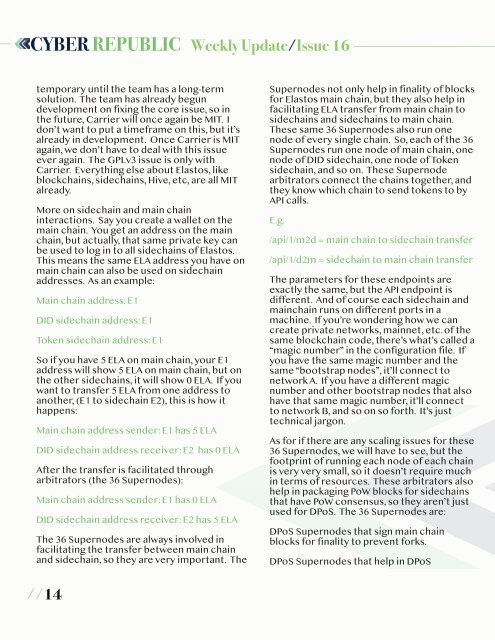Cyber Republic Weekly Update 16
This entire Weekly Update is focused on the upcoming DPoS elections! And what community buzz there’s been! Supernode pools have formed, the CR Forum is filling up with DPoS topics, and the Elastos Foundation has made a recent announcement that influences the voting process. We, the CR Weekly Newsletter team, want the whole community informed about the available Supernode Candidates. Keep reading to learn more about the Candidates up for election this month.
This entire Weekly Update is focused on the upcoming DPoS elections! And what community buzz there’s been! Supernode pools have formed, the CR Forum is filling up with DPoS topics, and the Elastos Foundation has made a recent announcement that influences the voting process. We, the CR Weekly Newsletter team, want the whole community informed about the available Supernode Candidates. Keep reading to learn more about the Candidates up for election this month.
Create successful ePaper yourself
Turn your PDF publications into a flip-book with our unique Google optimized e-Paper software.
CYBER REPUBLIC <strong>Weekly</strong> <strong>Update</strong>/Issue <strong>16</strong><br />
temporary until the team has a long-term<br />
solution. The team has already begun<br />
development on fixing the core issue, so in<br />
the future, Carrier will once again be MIT. I<br />
don’t want to put a timeframe on this, but it’s<br />
already in development. Once Carrier is MIT<br />
again, we don’t have to deal with this issue<br />
ever again. The GPLv3 issue is only with<br />
Carrier. Everything else about Elastos, like<br />
blockchains, sidechains, Hive, etc, are all MIT<br />
already.<br />
More on sidechain and main chain<br />
interactions. Say you create a wallet on the<br />
main chain. You get an address on the main<br />
chain, but actually, that same private key can<br />
be used to log in to all sidechains of Elastos.<br />
This means the same ELA address you have on<br />
main chain can also be used on sidechain<br />
addresses. As an example:<br />
Main chain address: E1<br />
DID sidechain address: E1<br />
Token sidechain address: E1<br />
So if you have 5 ELA on main chain, your E1<br />
address will show 5 ELA on main chain, but on<br />
the other sidechains, it will show 0 ELA. If you<br />
want to transfer 5 ELA from one address to<br />
another, (E1 to sidechain E2), this is how it<br />
happens:<br />
Main chain address sender: E1 has 5 ELA<br />
DID sidechain address receiver: E2 has 0 ELA<br />
After the transfer is facilitated through<br />
arbitrators (the 36 Supernodes):<br />
Main chain address sender: E1 has 0 ELA<br />
DID sidechain address receiver: E2 has 5 ELA<br />
The 36 Supernodes are always involved in<br />
facilitating the transfer between main chain<br />
and sidechain, so they are very important. The<br />
Supernodes not only help in finality of blocks<br />
for Elastos main chain, but they also help in<br />
facilitating ELA transfer from main chain to<br />
sidechains and sidechains to main chain.<br />
These same 36 Supernodes also run one<br />
node of every single chain. So, each of the 36<br />
Supernodes run one node of main chain, one<br />
node of DID sidechain, one node of Token<br />
sidechain, and so on. These Supernode<br />
arbitrators connect the chains together, and<br />
they know which chain to send tokens to by<br />
API calls.<br />
E.g.<br />
/api/1/m2d = main chain to sidechain transfer<br />
/api/1/d2m = sidechain to main chain transfer<br />
The parameters for these endpoints are<br />
exactly the same, but the API endpoint is<br />
different. And of course each sidechain and<br />
mainchain runs on different ports in a<br />
machine. If you’re wondering how we can<br />
create private networks, mainnet, etc. of the<br />
same blockchain code, there’s what’s called a<br />
“magic number” in the configuration file. If<br />
you have the same magic number and the<br />
same “bootstrap nodes”, it’ll connect to<br />
network A. If you have a different magic<br />
number and other bootstrap nodes that also<br />
have that same magic number, it’ll connect<br />
to network B, and so on so forth. It’s just<br />
technical jargon.<br />
As for if there are any scaling issues for these<br />
36 Supernodes, we will have to see, but the<br />
footprint of running each node of each chain<br />
is very very small, so it doesn’t require much<br />
in terms of resources. These arbitrators also<br />
help in packaging PoW blocks for sidechains<br />
that have PoW consensus, so they aren’t just<br />
used for DPoS. The 36 Supernodes are:<br />
DPoS Supernodes that sign main chain<br />
blocks for finality to prevent forks.<br />
DPoS Supernodes that help in DPoS<br />
//14
















